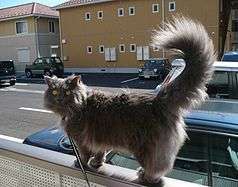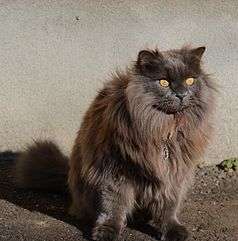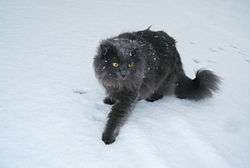Chantilly-Tiffany
| Chantilly-Tiffany | |
|---|---|
|
a Chantilly-Tiffany cat in the snow. | |
| Other names | Chantilly, Foreign Longhair |
| Origin | North America |
| Domestic cat (Felis catus) | |
The Chantilly-Tiffany or Chantilly/Tiffany, also known as the Chantilly or the Foreign Longhair, is a breed of cat derived mainly from cross-breeding long-haired Asians and Burmese. The breed originated in North America. This breed is considered distinct from the Asian Semi-longhair breed, the British variant. The Chantilly was thought extinct until the 1960s when two of these cats appeared during an estate sale.


Appearance
This cat has a semi-foreign body style and a full semi-long coat. The coat is silky, soft and smooth; the lack of undercoat usually makes grooming simpler than that of cats with an undercoat. The Chantilly-Tiffany is slow to mature and usually does not come into its full stature until about two years old. The eye color of the feline intensifies with age. The head should be a broad, modified wedge with gentle curves. It should have a medium length nose and a strong, broad, short, softly squared muzzle and defined but not obvious whisker pads.
The Chantilly-Tiffany originated in a chocolate color, but now is accepted in a range of colors including chocolate, blue, cinnamon, lilac, and fawn. Accepted patterns are solid, mackerel, ticked, and spotted tabby. The color is rich; shading in solids may occur toward the underside. The overall impression of an ideal Chantilly would be a semi-foreign cat of striking appearance resulting from the combination of its rich color and full, silky semi-longhair coat, plumed tail, contrasting neck ruff, and ear furnishings.
Eye color tends to be a very bright and clear yellow while the cat is young. As the cat becomes older, the color will become more golden.
Grooming
Some Chantilly-Tiffanys' overgroom. They tend to pull their own hair, which can lead to patches of baldness and the formation of digestive tract hairballs. To help prevent this, brush the cat at least every other day to help control loose and shedding hair.
History
In 1967, Jennie Robinson (Neotype Cattery) of New York purchased "Thomas" and "Shirley," a pair of semi-foreign longhaired chocolate cats with golden eyes and an unknown background, which were being sold as part of an estate sale. Ms. Robinson judged Thomas to be a little over a year old and Shirley about six months. Possibly the cats had the same parents but were not litter-mates.
Shirley's first litter was born in early 1969, containing six kittens, all similar in appearance and of a chocolate color, which surprised Robinson and her veterinarian. Robinson then undertook a breeding program to emphasise these traits. In the early 1970s, the ACA registered Thomas, Shirley, and many of their progeny as "Foreign-Longhairs."
Early breeders hypothesized that the cats might be of Burmese descent. However, when the first litter was born in May 1969, the kittens were dark colors with no points and pinkish paw pads, the opposite of traits that identify Burmese. All the cats in the United States of this breed descended from Thomas and Shirley. None were produced or bred to Burmese.
Some of Ms. Robinson's kittens were sold to Sigyn Lund (Sig Tim Hil Cattery), a Florida Burmese breeder who also took on the breeding program. The public thought the chocolate cats came from her Burmese, since their New York origin had not been publicized. Ms. Lund chose the breed-name "Tiffany," a name associated with elegance and class. She promoted the breed with the "Tiffany" name because judges felt the "Foreign-Longhair" name was too general. They suggested the name "Mahogany" would be more descriptive. None were ever registered under the Lund name from the Sig Tim Hil Cattery. When ACA dropped the breed from recognition because it was so rare, all breed representatives became unregistered as a result; therefore the breed continued to be advertised as "Burmese."
External links
| Look up chantilly in Wiktionary, the free dictionary. |
| Wikimedia Commons has media related to Tiffany (cat). |
